纳撒尼尔霍桑是美国十九世纪最杰出的浪漫主义作家之...
- 格式:doc
- 大小:221.50 KB
- 文档页数:45
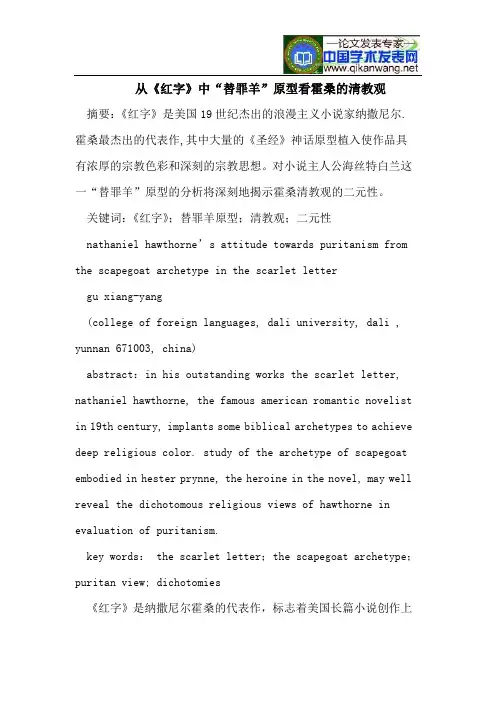
从《红字》中“替罪羊”原型看霍桑的清教观摘要:《红字》是美国19世纪杰出的浪漫主义小说家纳撒尼尔.霍桑最杰出的代表作,其中大量的《圣经》神话原型植入使作品具有浓厚的宗教色彩和深刻的宗教思想。
对小说主人公海丝特白兰这一“替罪羊”原型的分析将深刻地揭示霍桑清教观的二元性。
关键词:《红字》;替罪羊原型;清教观;二元性nathaniel hawthorne’s attitude towards puritanism fromthe scapegoat archetype in the scarlet lettergu xiang-yang(college of foreign languages, dali university, dali ,yunnan 671003, china)abstract:in his outstanding works the scarlet letter, nathaniel hawthorne, the famous american romantic novelist in 19th century, implants some biblical archetypes to achieve deep religious color. study of the archetype of scapegoat embodied in hester prynne, the heroine in the novel, may well reveal the dichotomous religious views of hawthorne inevaluation of puritanism.key words: the scarlet letter;the scapegoat archetype;puritan view; dichotomies《红字》是纳撒尼尔霍桑的代表作,标志着美国长篇小说创作上的一个重大突破。
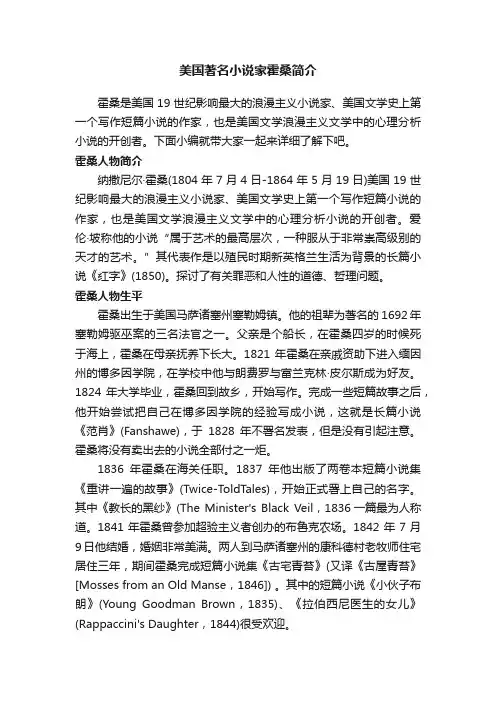
美国著名小说家霍桑简介霍桑是美国19世纪影响最大的浪漫主义小说家、美国文学史上第一个写作短篇小说的作家,也是美国文学浪漫主义文学中的心理分析小说的开创者。
下面小编就带大家一起来详细了解下吧。
霍桑人物简介纳撒尼尔·霍桑(1804年7月4日-1864年5月19日)美国19世纪影响最大的浪漫主义小说家、美国文学史上第一个写作短篇小说的作家,也是美国文学浪漫主义文学中的心理分析小说的开创者。
爱伦·坡称他的小说“属于艺术的最高层次,一种服从于非常崇高级别的天才的艺术。
”其代表作是以殖民时期新英格兰生活为背景的长篇小说《红字》(1850)。
探讨了有关罪恶和人性的道德、哲理问题。
霍桑人物生平霍桑出生于美国马萨诸塞州塞勒姆镇。
他的祖辈为著名的1692年塞勒姆驱巫案的三名法官之一。
父亲是个船长,在霍桑四岁的时候死于海上,霍桑在母亲抚养下长大。
1821年霍桑在亲戚资助下进入缅因州的博多因学院,在学校中他与朗费罗与富兰克林·皮尔斯成为好友。
1824年大学毕业,霍桑回到故乡,开始写作。
完成一些短篇故事之后,他开始尝试把自己在博多因学院的经验写成小说,这就是长篇小说《范肖》(Fanshawe),于1828年不署名发表,但是没有引起注意。
霍桑将没有卖出去的小说全部付之一炬。
1836年霍桑在海关任职。
1837年他出版了两卷本短篇小说集《重讲一遍的故事》(Twice-ToldTales),开始正式署上自己的名字。
其中《教长的黑纱》(The Minister's Black Veil,1836一篇最为人称道。
1841年霍桑曾参加超验主义者创办的布鲁克农场。
1842年7月9日他结婚,婚姻非常美满。
两人到马萨诸塞州的康科德村老牧师住宅居住三年,期间霍桑完成短篇小说集《古宅青苔》(又译《古屋青苔》[Mosses from an Old Manse,1846]) 。
其中的短篇小说《小伙子布朗》(Young Goodman Brown,1835)、《拉伯西尼医生的女儿》(Rappaccini's Daughter,1844)很受欢迎。
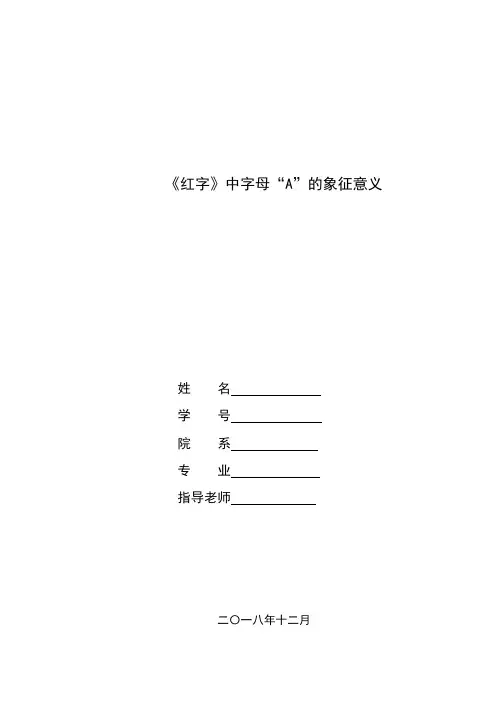
《红字》中字母“A”的象征意义姓名学号院系专业指导老师二〇一八年十二月目录摘要 (1)一、绪论 (2)二、象征手法 (2)三、字母“A”的象征意义 (2)3.1象征通奸 (2)3.2象征爱情 (2)3.3象征痛苦 (3)3.4象征孤独 (3)3.5象征能干 (3)四、总结 (3)参考文献 (5)《红字》中字母“A”的象征意义摘要《红字》是 19 世纪美国著名的浪漫主义小说家霍桑的代表作。
作品极具象征意义,表达了很深的寓意。
本文通过对字母“A”的象征意义进行分析,旨在了解字母“A”的丰富的内涵,从而更好的理解《红字》这篇小说。
关键词:《红字》;字母“A”;象征意义一、绪论纳撒尼尔·霍桑是美国十九世纪的一个杰出的浪漫主义作家。
他善于描绘现实社会中的黑暗与人性的阴暗,作品中经常对于道德和罪恶问题进行探讨。
霍桑的著名的作品《红字》是美国文学史上第一部具有象征意义的小说。
小说中通过对女主人公海斯特生活中的悲惨遭遇进行了形象的描绘,小说反映了当时教徒殖民统治的黑暗,残酷,和社会虚伪与丑陋。
霍桑完美的把一个悲惨女性海丝特的形象展现到读者面前,她有着善良,勇于追求爱情和幸福的性格特点,并且不畏惧困难,敢于在逆境中面对现实,坚持不懈,因此作品把一位坚强女性的形象成功的塑造了出来。
二、象征手法象征是一种文学创作的艺术方法。
它基于事物之间的某种联系,并使用某人的特定形象把某些抽象概念表现出来,像是人的思想和情感。
它可以使文章更具艺术性,而正确使用象征主义可以将一些更抽象的精神品质转化为具体和可感知的形象,使文章有更深的内涵,从而给读者回味无穷,提升作品的价值。
在《红字》这部小说中,霍桑给出了一个红色字母“A”,它是整本书中的主线,具有典型的象征意义。
霍桑巧妙地将红色字母“A”放在整本小说中,使其从文章的开始到结束巧妙的结合在一起,而它也以不同的形式出现在不同的地方。
虽然作者并没有明确的告诉读者字母“A”象征的东西,而是随着故事的发展而变化,但是读者可以根据自身的理解去体会字母“A”的象征意义。
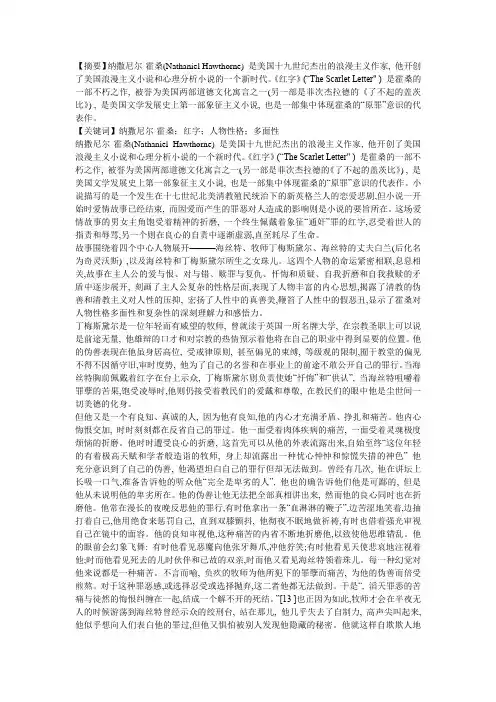
【摘要】纳撒尼尔·霍桑(Nathaniel Hawthorne) 是美国十九世纪杰出的浪漫主义作家, 他开创了美国浪漫主义小说和心理分析小说的一个新时代。
《红字》(“The Scarlet Letter" ) 是霍桑的一部不朽之作, 被誉为美国两部道德文化寓言之一(另一部是菲次杰拉德的《了不起的盖茨比》) , 是美国文学发展史上第一部象征主义小说, 也是一部集中体现霍桑的“原罪”意识的代表作。
【关键词】纳撒尼尔·霍桑;红字;人物性格;多面性纳撒尼尔·霍桑(Nathaniel Hawthorne) 是美国十九世纪杰出的浪漫主义作家, 他开创了美国浪漫主义小说和心理分析小说的一个新时代。
《红字》(“The Scarlet Letter" ) 是霍桑的一部不朽之作, 被誉为美国两部道德文化寓言之一(另一部是菲次杰拉德的《了不起的盖茨比》) , 是美国文学发展史上第一部象征主义小说, 也是一部集中体现霍桑的“原罪”意识的代表作。
小说描写的是一个发生在十七世纪北美清教殖民统治下的新英格兰人的恋爱悲剧,但小说一开始时爱情故事已经结束, 而因爱而产生的罪恶对人造成的影响则是小说的要旨所在。
这场爱情故事的男女主角饱受着精神的折磨, 一个终生佩戴着象征“通奸”罪的红字,忍受着世人的指责和辱骂,另一个则在良心的自责中逐渐虚弱,直至耗尽了生命。
故事围绕着四个中心人物展开———海丝特、牧师丁梅斯黛尔、海丝特的丈夫白兰(后化名为奇灵沃斯) ,以及海丝特和丁梅斯黛尔所生之女珠儿。
这四个人物的命运紧密相联,息息相关,故事在主人公的爱与恨、对与错、赎罪与复仇、忏悔和质疑、自我折磨和自我救赎的矛盾中逐步展开, 刻画了主人公复杂的性格层面,表现了人物丰富的内心思想,揭露了清教的伪善和清教主义对人性的压抑, 宏扬了人性中的真善美,鞭笞了人性中的假恶丑,显示了霍桑对人物性格多面性和复杂性的深刻理解力和感悟力。
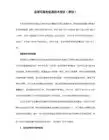
牧师的黑面纱《牧师的黑面纱》写于1863年,是美国十九世纪杰出浪漫主义作家纳撒尼尔·霍桑(1804-1864)的最重要短篇小说之一。
小说最初发表在《Token》杂志上,随之见于1837年出版的霍桑短篇小说集《故事重述》(Twice-Told Tales)中。
《牧师的黑面纱》可谓上乘之作,作者以其独特娴熟的艺术技巧表达了深邃的内涵,从而奠定了它在美国文学史上的不朽地位。
《牧师的黑面纱》讲述了年轻而令人尊重的胡波(Mr. Hooper)牧师戴上黑面纱布道直至死亡也不肯摘下来的故事。
故事中我们见到的是一位孤独的牧师,由于这块遮在脸上的面纱,引起人的猜测、反感,甚至恐惧,无人与他或敢与他进行面对面地交流。
正如那位老妇人所说的:I don’t like it … He has changed himself into something awful, only by hiding his face.”(P30)(我不喜欢这块头纱……他把脸这么一遮,整个的人就成了一个可怕的怪物)。
就连他的女友伊利莎白在无法劝说他摘下面纱后也只得弃他而去。
难怪他感叹到:“Oh! You know not how lonely I am, and how frightened, to be alone behind my black veil. Do not leave me in this miserable obscurity forever.”(p35; 啊,我一个人在黑纱后是多么孤独,多么害怕!不要让我永远留在这悲惨的黑暗中呢!)。
牧师的孤独显然是与他所带的黑纱是有联系的。
他为什么总是要带着它而忍受孤独呢?小说的背景是清教的新英格兰,这不能不使读者联想到作者的家庭背景及清教传说对当时人们的影响。
霍桑于1804年7月出生于马萨诸塞州塞勒姆市,一个富有的清教世家。
他的祖辈中第一位来到美国的叫做William Hathorne,1630年来到新英格兰,后来卷入了对震颤派教徒(Shakers)的迫害。
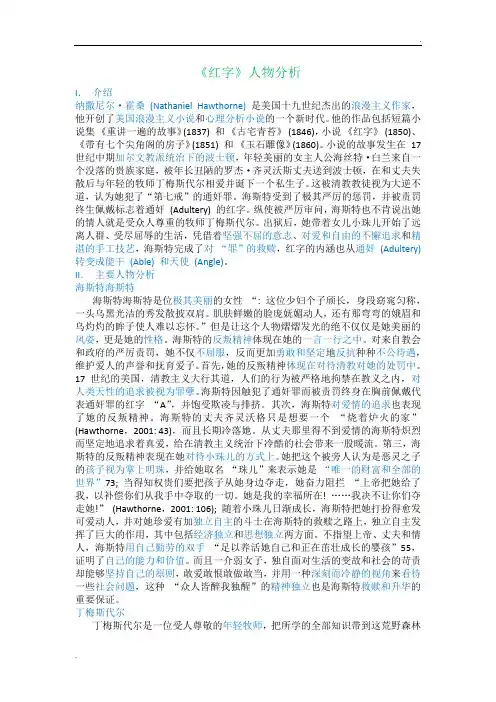
《红字》人物分析I.介绍纳撒尼尔·霍桑(Nathaniel Hawthorne)是美国十九世纪杰出的浪漫主义作家,他开创了美国浪漫主义小说和心理分析小说的一个新时代。
他的作品包括短篇小说集《重讲一遍的故事》(1837) 和《古宅青苔》(1846),小说《红字》(1850)、《带有七个尖角阁的房子》(1851) 和《玉石雕像》(1860)。
小说的故事发生在17 世纪中期加尔文教派统治下的波士顿,年轻美丽的女主人公海丝特·白兰来自一个没落的贵族家庭,被年长丑陋的罗杰·齐灵沃斯丈夫送到波士顿,在和丈夫失散后与年轻的牧师丁梅斯代尔相爱并诞下一个私生子。
这被清教教徒视为大逆不道,认为她犯了“第七戒”的通奸罪。
海斯特受到了极其严厉的惩罚,并被责罚终生佩戴标志着通奸(Adultery) 的红字。
纵使被严厉审问,海斯特也不肯说出她的情人就是受众人尊重的牧师丁梅斯代尔。
出狱后,她带着女儿小珠儿开始了远离人群、受尽屈辱的生活,凭借着坚强不屈的意志、对爱和自由的不懈追求和精湛的手工技艺,海斯特完成了对“罪”的救赎,红字的内涵也从通奸(Adultery) 转变成能干(Able) 和天使(Angle)。
II.主要人物分析海斯特海斯特海斯特海斯特是位极其美丽的女性“: 这位少妇个子颀长,身段窈窕匀称,一头乌黑光洁的秀发散披双肩。
肌肤鲜嫩的脸庞妩媚动人,还有那弯弯的娥眉和乌灼灼的眸子使人难以忘怀。
”但是让这个人物熠熠发光的绝不仅仅是她美丽的风姿,更是她的性格。
海斯特的反叛精神体现在她的一言一行之中。
对来自教会和政府的严厉责罚,她不仅不屈服,反而更加勇敢和坚定地反抗种种不公待遇,维护爱人的声誉和抚育爱子。
首先,她的反叛精神体现在对待清教对她的处罚中。
17 世纪的美国,清教主义大行其道,人们的行为被严格地拘禁在教义之内,对人类天性的追求被视为罪孽。
海斯特因触犯了通奸罪而被责罚终身在胸前佩戴代表通奸罪的红字“A”,并饱受欺凌与排挤。
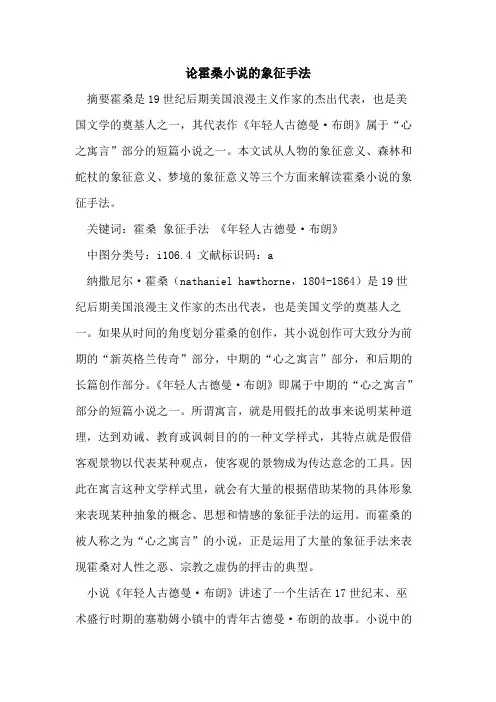
论霍桑小说的象征手法摘要霍桑是19世纪后期美国浪漫主义作家的杰出代表,也是美国文学的奠基人之一,其代表作《年轻人古德曼·布朗》属于“心之寓言”部分的短篇小说之一。
本文试从人物的象征意义、森林和蛇杖的象征意义、梦境的象征意义等三个方面来解读霍桑小说的象征手法。
关键词:霍桑象征手法《年轻人古德曼·布朗》中图分类号:i106.4 文献标识码:a纳撒尼尔·霍桑(nathaniel hawthorne,1804-1864)是19世纪后期美国浪漫主义作家的杰出代表,也是美国文学的奠基人之一。
如果从时间的角度划分霍桑的创作,其小说创作可大致分为前期的“新英格兰传奇”部分,中期的“心之寓言”部分,和后期的长篇创作部分。
《年轻人古德曼·布朗》即属于中期的“心之寓言”部分的短篇小说之一。
所谓寓言,就是用假托的故事来说明某种道理,达到劝诫、教育或讽刺目的的一种文学样式,其特点就是假借客观景物以代表某种观点,使客观的景物成为传达意念的工具。
因此在寓言这种文学样式里,就会有大量的根据借助某物的具体形象来表现某种抽象的概念、思想和情感的象征手法的运用。
而霍桑的被人称之为“心之寓言”的小说,正是运用了大量的象征手法来表现霍桑对人性之恶、宗教之虚伪的抨击的典型。
小说《年轻人古德曼·布朗》讲述了一个生活在17世纪末、巫术盛行时期的塞勒姆小镇中的青年古德曼·布朗的故事。
小说中的布朗不顾新婚妻子的反对,执意要参加魔鬼的约会,并亲眼见证了人性丑恶。
小说采用了超现实主义的手法,虚构了魔鬼、出现幻觉的森林、突然醒来的梦境等具有深刻寓意的人或景物,运用了多种多样的象征手法,使小说充满了浓郁的寓言感。
一人物的象征意义在《年轻人古德曼·布朗》中,霍桑把小说里的人物分成了两大类,即生活里的好人和生活里的坏人。
很显然,年轻的布朗夫妇就是典型的好人,因为“古德曼”在英文中是“好人”的意思,而布朗的妻子费丝的名字在英文中就是“忠实”、“信仰”的意思,对于妻子的忠实,布朗显然是深信不疑的,所以小说里才写道:“这名字对她恰如其分。
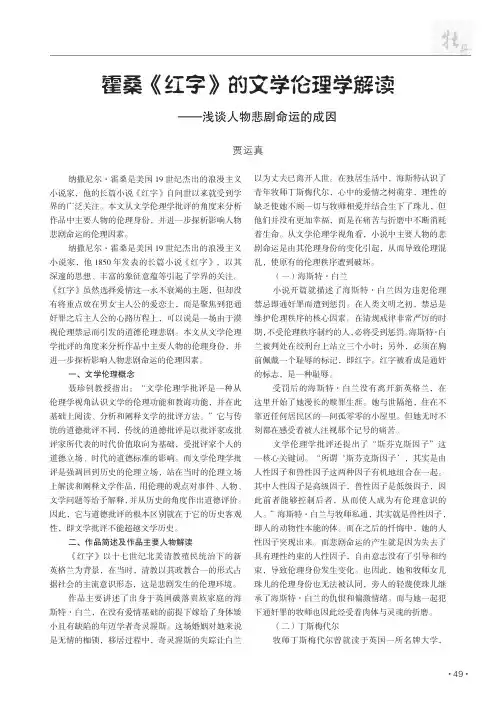
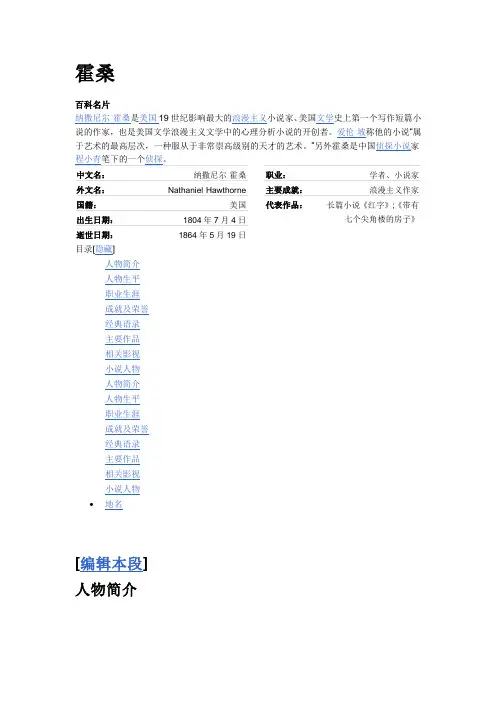
霍桑百科名片纳撒尼尔·霍桑是美国19世纪影响最大的浪漫主义小说家、美国文学史上第一个写作短篇小说的作家,也是美国文学浪漫主义文学中的心理分析小说的开创者。
爱伦·坡称他的小说“属于艺术的最高层次,一种服从于非常崇高级别的天才的艺术。
”另外霍桑是中国侦探小说家程小青笔下的一个侦探。
中文名: 纳撒尼尔·霍桑 外文名: Nathaniel·Hawthorne国籍: 美国出生日期: 1804年7月4日逝世日期: 1864年5月19日职业: 学者、小说家主要成就: 浪漫主义作家 代表作品: 长篇小说《红字》;《带有七个尖角楼的房子》目录[隐藏] 人物简介 人物生平 职业生涯 成就及荣誉 经典语录 主要作品相关影视 小说人物 人物简介 人物生平职业生涯成就及荣誉 经典语录主要作品相关影视 小说人物地名[编辑本段]人物简介纳撒尼尔·霍桑生平简介介绍:纳撒尼尔·霍桑,(Nathaniel Hawthorne 1804~1864)美国小说家,是美国19世纪影响最大的浪漫主义小说家和心理小说家。
1804年7月4日出生于马萨诸塞州塞勒姆镇一个没落的世家。
他的祖辈之中有人曾参与清教徒迫害异端的事件,为著名的1692年“塞勒姆驱巫案”的3 名法官之一。
这段历史对霍桑的思想产生了深刻的影响。
霍桑的父亲是一名船长,在他4岁时去世。
1821年霍桑在亲戚资助下进入博多因学院,同学中有诗人朗费罗与后来当选为总统的皮尔斯等。
1825年大学毕业,回到塞勒姆镇,从事写作。
他曾匿名发表长篇小说《范肖》(1828)和几十个短篇作品,陆续出版短篇小说集《古宅青苔》(1843)、《雪影》(1851)等,逐渐得到重视和好评。
1836年和1846年霍桑曾两度在海关任职,1841年曾参加超验主义者创办的布鲁克农场。
他于1842年结婚,在康科德村居住,结识了作家爱默生、梭罗等人。
18 48年由于政见与当局不同,失去海关的职务,便致力于创作活动,写出了他最重要的长篇小说《红字》(1850)。
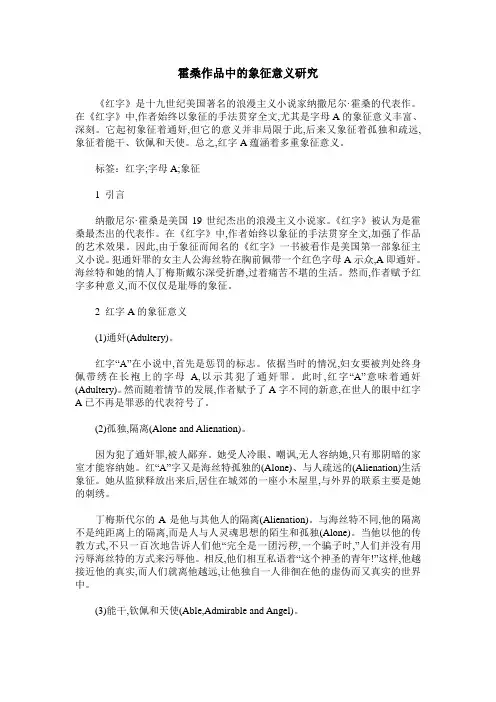
霍桑作品中的象征意义研究《红字》是十九世纪美国著名的浪漫主义小说家纳撒尼尔·霍桑的代表作。
在《红字》中,作者始终以象征的手法贯穿全文,尤其是字母A的象征意义丰富、深刻。
它起初象征着通奸,但它的意义并非局限于此,后来又象征着孤独和疏远,象征着能干、钦佩和天使。
总之,红字A蕴涵着多重象征意义。
标签:红字;字母A;象征1 引言纳撒尼尔·霍桑是美国19世纪杰出的浪漫主义小说家。
《红字》被认为是霍桑最杰出的代表作。
在《红字》中,作者始终以象征的手法贯穿全文,加强了作品的艺术效果。
因此,由于象征而闻名的《红字》一书被看作是美国第一部象征主义小说。
犯通奸罪的女主人公海丝特在胸前佩带一个红色字母A示众,A即通奸。
海丝特和她的情人丁梅斯戴尔深受折磨,过着痛苦不堪的生活。
然而,作者赋予红字多种意义,而不仅仅是耻辱的象征。
2 红字A的象征意义(1)通奸(Adultery)。
红字“A”在小说中,首先是惩罚的标志。
依据当时的情况,妇女要被判处终身佩带绣在长袍上的字母A,以示其犯了通奸罪。
此时,红字“A”意味着通奸(Adultery)。
然而随着情节的发展,作者赋予了A字不同的新意,在世人的眼中红字A已不再是罪恶的代表符号了。
(2)孤独,隔离(Alone and Alienation)。
因为犯了通奸罪,被人鄙弃。
她受人冷眼、嘲讽,无人容纳她,只有那阴暗的家室才能容纳她。
红“A”字又是海丝特孤独的(Alone)、与人疏远的(Alienation)生活象征。
她从监狱释放出来后,居住在城郊的一座小木屋里,与外界的联系主要是她的刺绣。
丁梅斯代尔的A是他与其他人的隔离(Alienation)。
与海丝特不同,他的隔离不是纯距离上的隔离,而是人与人灵魂思想的陌生和孤独(Alone)。
当他以他的传教方式,不只一百次地告诉人们他“完全是一团污秽,一个骗子时,”人们并没有用污辱海丝特的方式来污辱他。
相反,他们相互私语着“这个神圣的青年!”这样,他越接近他的真实,而人们就离他越远,让他独自一人徘徊在他的虚伪而又真实的世界中。
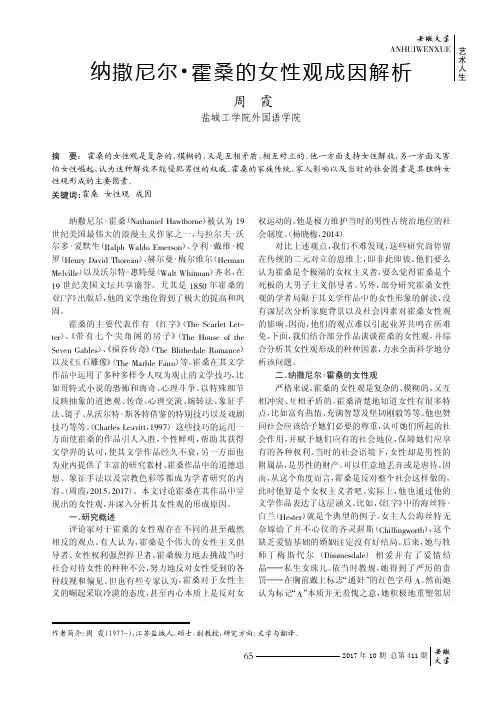
ANHUIWENXUE 安徽文学安徽文学2017年10期总第411期作者简介:周霞(1977-),江苏盐城人,硕士,副教授,研究方向:文学与翻译。
纳撒尼尔·霍桑的女性观成因解析周霞盐城工学院外国语学院摘要:霍桑的女性观是复杂的、模糊的,又是互相矛盾、相互对立的。
他一方面支持女性解放,另一方面又害怕女性崛起,认为这种解放不能侵犯男性的权威。
霍桑的家族传统、家人影响以及当时的社会因素是其独特女性观形成的主要因素。
关键词院霍桑女性观成因纳撒尼尔·霍桑(Nathaniel Hawthorne )被认为19世纪美国最伟大的浪漫主义作家之一,与拉尔夫·沃尔多·爱默生(Ralph Waldo Emerson )、亨利·戴维·梭罗(Henry David Thoreau )、赫尔曼·梅尔维尔(Herman Melville )以及沃尔特·惠特曼(Walt Whitman )齐名,在19世纪美国文坛共享盛誉。
尤其是1850年霍桑的《红字》出版后,他的文学地位得到了极大的提高和巩固。
霍桑的主要代表作有《红字》(The Scarlet Let 原ter )、《带有七个尖角阁的房子》(The House of the Seven Gables )、《福谷传奇》(The Blithedale Romance )以及《玉石雕像》(The Marble Faun )等。
霍桑在其文学作品中运用了多种多样令人叹为观止的文学技巧,比如哥特式小说的恐怖和离奇、心理斗争、以特殊细节反映抽象的道德观、传奇、心理交流、婉转法、象征手法、镜子、从沃尔特·斯各特借鉴的特别技巧以及戏剧技巧等等。
(Charles Leavitt ,1997)这些技巧的运用一方面使霍桑的作品引人入胜,个性鲜明,帮助其获得文学界的认可,使其文学作品经久不衰,另一方面也为业内提供了丰富的研究素材。
湘潭大学硕士学位论文霍桑对超验主义的吸收、怀疑与超越姓名:廖杨洁申请学位级别:硕士专业:比较文学与世界文学指导教师:曾思艺20060501摘要纳撒尼尔・霍桑是19世纪美国浪漫主义的代表作家。
他开创了美国小说中富有象征性的浪漫形式,用天才的艺术才能创造出多部具有审美价值的传世佳作。
霍桑天赋的才能与他善于思考的秉性是不可分割的。
霍桑生活在一个拜金主义泛滥的时代,精神危机促使他致力于对人性的探讨,挖掘心灵的罪恶,寻求人类的拯救之途。
在对这些问题的思索过程中,盛行于当时的崇尚精神的超验主义自然引起他的关注。
他曾一度加入该组织的试验,实践超验主义的理论。
在与超验主义者接触的过程中,霍桑受到了潜移默化的影响。
他吸收了超验主义的超灵思想,崇尚精神,反对趋物主义,对物质压抑精神的社会现实予以强烈批判;呼唤人们回归自然,在自然中获得重生。
同时霍桑运用超验主义提倡的象征手法进行创作,自然物在他的作品中往往具有了超越本身的第二价值,被赋予丰富的内涵。
在研究新英格兰历史的基础上,他创作出大量具有本土特色的作品,为美国文学添上色彩浓重的一笔。
深受清教主义影响的霍桑也表现出了对超验主义人性观的怀疑,并对超验主义所推崇的个人主义进行了深刻反思。
在这些思考的基础上,霍桑提出通过对罪恶的反省来使人获得升华的超越之途和通过爱来消解罪恶的救赎之路。
本文试图在介绍超验主义及其主要思想的基础上,通过梳理霍桑与超验主义的渊源关系,探讨霍桑对超验主义的吸收、怀疑和超越。
论文分别从超灵观、文艺观两方面结合霍桑的作品阐述霍桑对超验主义思想的接受;其次,在对霍桑生活经历分析的基础上阐述霍桑对超验主义人性观的怀疑和对个人主义的反思,探讨霍桑对超验主义的超越,以期较全面地把握霍桑与超验主义的关系,更深刻地理解霍桑的创作思想。
关键词:霍桑;超验主义;接受;怀疑;超越AbstractNathaniel Hawthorne is a romanticism representative writer of American in 19th century .He started romantic Form with symbolic express, used genius talent wrote many excellent works with aesthetic value . Hawthorne’s art talent is integrated with his pandering habit. Hawthorne lives in the time when money worships was overrunning, the spirit crisis urged him to devote himself to the human nature reseach, excavats mind evil, seeked the way to save humanity .when he reseached these questions, the transcendentalism which prevalented in that time, it’s advocation for spirit arouse Hawthorne’s interest naturally, even once attracted him to join this organization, practiced t transcendentalism’s principle theory. During the time he contacted with transcendentalists frequently, Hawthorne also got subtle influences of them. He accepted the oversoul view of transcendentalism, advocated spirit, opposed to substance whishop. he gave intense critique to the society which matter constrained the spiritual. He summoned people to return nature, obtained the rebirth in the nature. Hawthorne also applied symbolic idea in his works, Everything in the his works was viewed as an expression of the divine spirit, they have many meanings also. On the found of studing the New England history, he wrote massively works which displayed native characteristic. They added strong color for American independent culture. But Hawthorne deeply influenced by puritanism doctrine, so he displayed his suspicion to transcendentalism human nature view and expressed his rethink about individual. On the foundation of this ponders, Hawthorne proposed through wicked causes the human to obtain the sublimation way to surmounting and through love dispelling the evil as a redeem road.On the basic of introducing transcendentalism principle ideas, this article through arranges the relation between Hawthorne and transcendentalism, discusses Hawthorne’s acception, suspicion and transcendence to transcendentalism. The thesis from the Oversoul view, literatrue view aspects combines with Hawthorne’s works elaborate Hawthorne’s acception to transcendentalism; explore the transcendence of Hawthorne to transcendentalism. Expect to master the relation between Hawthorne and transcendentalism comprehensively and comprehend Hawthorne’s creative work more deeply.Keywords: Hawthorne; transcendentalism; acceptance; suspicion; transcendence绪论纳撒尼尔・霍桑是十九世纪美国最杰出的小说家之一。
女性主义视域下《红字》的解读摘要:纳撒尼尔·霍桑是19世纪最具影响力的美国作家之一,被认为是美国浪漫主义小说和心理分析小说的创始人。
代表作《红字》因蕴含丰富的内涵,因此,在文学史上堪称经典。
这部作品被众多学者从不同的角度进行研究,如原型理论、心理分析和女性主义等。
在其生活经历和十九世纪女权运动的影响下,霍桑孕育了女性主义意识,因此本文试图从女性主义的理论为出发点,解读《红字》的文本意蕴,以透析《红字》的经典之处。
关键词:霍桑;红字;女性主义;女性主义意识一、引言霍桑凭借其著作《红字》一书而名声鹊起。
这部小说因其紧凑密接的文章结构、丰富多样的隐喻象征、富有诗情的语言表达使其散发迷人的文学魅力。
《红字》讲述了一个禁忌且敏感的事实:女主人公海斯特与牧师的通奸罪行。
经过通奸事件带来一些列的影响之后,海斯特逐渐探索自己的内心世界、自我反思、女性主义意识自我觉醒。
通过对文本的解读和历史情境的分析,读者可以感受到霍桑的女性主义气息愈加强烈。
二、霍桑及《红字》简介(一)霍桑简介霍桑被誉为十九世纪最伟大的美国作家之一,他在文学作品中保留了美国文学的基本属性、特定主体、结构分析。
罗伯特称,“《红字》属于最高层次的艺术。
”1梅尔维尔还曾将霍桑和莎士比亚作对比,由此可见霍桑在文学界的地位。
博尔赫斯也曾因霍桑高超的艺术技巧而给予了高度的赞许。
在霍桑作品中,他所传达出了未来的可预知性以及永恒、经典的自然属性。
他以其独特的视角关注社会问题,例如:人性、命运,特别是女性在社会现实中的地位。
(二)《红字》简介小说的背景发生于十七世纪中期清教主义遍布的波士顿。
一位年轻、美丽、羸弱的女性——海斯特被丈夫齐林沃斯先于一步安排到波士顿。
孤身异地的她过着艰苦的生活。
在此期间,她与一位牧师——丁梅斯代尔相爱,最终诞下了一名女婴。
因为海斯特无视清教的教义、违背清教的道义、与人通奸并被检举,因此胸前佩戴具有通奸标志的红字A。
三、霍桑的女性主义意识家庭和社会因素对霍桑的女性主义观从不同的方面有着不同的影响。
纳撒尼尔霍桑是美国十九世纪最杰出的浪漫主义作家之...AbstractNathaniel Hawthorne‘s ―The Birthmark‖, s imilar to other Hawthorne‘s short stories, is allegorical and gloomy, digging deep to reveal the darker aspect of human nature. Throughout the story, Hawthorne employs overwrought symbolism and other various literary devices to enhance his theme that limitless power of science is destructive. With the purpose of examining how Hawthorne uses stylistic techniques to engross readers in this incredible story, this thesis will firstly present an overview of stylistics and introduce some influential previous researches on Hawthorne and ―The Birthmark‖, which are followed by a brief account of Dark Romanticism. Furthermore, it will carry out a comprehensive stylistic analysis of this story in phonetic, lexical, syntactic, semantic and contextual aspects. Finally, since ―The Birthmark‖ bears major features of the unique writing style of Dark Romanticism, a conclusion will be drawn to summarize the main characteristics of this genre which are embodied in ―The Birthmark‖. Thus, a fuller appreciation of this story as well as that of the American Dark Romanticism will be ultimately achieved.Key Words: Hawthorne, Dark Romanticism, stylistic analysis, psychology, moral seriousness, complexity摘要纳撒尼尔·霍桑是美国十九世纪最杰出的浪漫主义作家之一,其小说风格独特,对美国文学发展产生了积极深远的影响。
霍桑作品自然人形象纳撒尼尔·霍桑是19 世纪美国浪漫主义最重要的代表作家,在他的长篇小说中塑造了一系列自然人形象。
在初期的不可熟之作、第一部长篇小说《范肖》 (1828) 中,塑造了一个贞洁的姑娘埃伦·郎顿,在她身上就已有了此后这个系列人物的雏形。
在霍桑此后创作的长篇小说中,此类形象向来没有中止过:《红字》(1849) 里的珠儿、《七个尖角顶的宅第》 (1851) 里的菲比·潘钦、《玉石人像》(1860) 里的多纳泰罗等。
他们构成了霍桑人物世界里的自然人家族. 在《玉石人像》里,作家更是明确地提出了“自然人”的说法。
他们是作家心目中的理想人物,他们与集中表现社会黑暗和人类罪恶的社会人一同,服务于霍桑的“性本恶”思想。
本文主要经过这几个人物,剖析霍桑笔下的自然人形象、作家创作的动因以及他对此类人物的思虑。
霍桑笔下的这些自然人形象是他的著作中难得的惹人注视的亮点,发散着独到的人品魅力。
作品中的自然人缘于以下几方面:第一,这些人物都处于社会的边沿状态,生活在远离尘嚣的世界里。
《红字》里的珠儿是父亲母亲“罪恶”的产物,她和犯通奸罪的母亲海斯特被社会所遗弃,但这个凡间中的“罪孽”,却在大自然中遇到了欢迎和招待:她忧如是自然的女儿,“丛林母亲以及养育的这些野兽,全都在此人类的孩子身上辨出了一种和蔼的野味”。
《七个尖角顶的宅第》中的菲比固然有潘钦家族的尊贵血统,但她其实不是作为一个潘钦家的人长大的,由于母亲出生贫贱、家庭贫寒,她生在乡间、擅长田间,大自然是她自由呼吸的天地。
《玉石人像》中的多纳泰罗的出身更富裕传奇色彩,他的先人是半人半神半兽的农牧神,他生活的贝尼山老城堡如同世外桃源,远离人间的喧哗和纷乱,他常流连于山川泉林之间,于是有了自然界的灵气,甚至能与动物沟通思想感情。
这些人物独到的出身和人生经历使他们生活在自然状态里,进而不自觉地将他们与资本主义社会的文明、罪恶隔走开来。
AbstractNathaniel Hawthorne‘s ―The Birthmark‖, s imilar to other Hawthorne‘s short stories, is allegorical and gloomy, digging deep to reveal the darker aspect of human nature. Throughout the story, Hawthorne employs overwrought symbolism and other various literary devices to enhance his theme that limitless power of science is destructive. With the purpose of examining how Hawthorne uses stylistic techniques to engross readers in this incredible story, this thesis will firstly present an overview of stylistics and introduce some influential previous researches on Hawthorne and ―The Birthmark‖, which are followed by a brief account of Dark Romanticism. Furthermore, it will carry out a comprehensive stylistic analysis of this story in phonetic, lexical, syntactic, semantic and contextual aspects. Finally, since ―The Birthmark‖ bears major features of the unique writing style of Dark Romanticism, a conclusion will be drawn to summarize the main characteristics of this genre which are embodied in ―The Birthmark‖. Thus, a fuller appreciation of this story as well as that of the American Dark Romanticism will be ultimately achieved.Key Words: Hawthorne, Dark Romanticism, stylistic analysis, psychology, moral seriousness, complexity摘要纳撒尼尔·霍桑是美国十九世纪最杰出的浪漫主义作家之一,其小说风格独特,对美国文学发展产生了积极深远的影响。
《胎记》描述了一个企图依靠科学手段将妻子脸上胎记除去的科学家最终导致妻子死亡的悲剧,批判了人类掌握科学技术后日益膨胀的欲望。
正如霍桑其他揭露人性之“恶”的作品,《胎记》运用了象征手法为故事增添了浓厚的神秘主义,此外,多种文学创作手段的结合也使《胎记》在内容与形式上达到和谐统一并产生强烈的艺术美感。
这部作品基调忧郁暗淡,因此被视为消极浪漫主义的代表作之一。
本文将首先对文体学的相关理论进行归纳,接着总结前人对霍桑及《胎记》所做的研究分析,再简单介绍“消极浪漫主义”的艺术风格。
全文将结合文体学及语言学的理论分别从语音、词汇、语义、句法等方面对《胎记》的文体风格进行详细的剖析,力求通过展现故事的文学美感来深化对其主题的理解,最终归纳出《胎记》中“消极浪漫主义”的显著文体特点。
关键词:霍桑,消极浪漫主义,文体分析,心理描写,忧郁严肃,复杂AcknowledgementsIt was really a laborious task to accomplish a B.A. thesis. I have received much support and help in the process of writing the thesis. Particularly, I would like to express my sincere appreciation to my supervisor, Mr. Zhang Huahong, for his valuable suggestions, generous instructions and patient revision of my thesis. Without his willingness to share knowledge and ideas, it would be much more difficult for me to work through the thinking and writing process.Additionally, I owe much to the teachers and professors who have ever taught me throughout my college years. Their teaching and assistance have been always pushing me along my academic road.I am also grateful to my good friends and classmates for their care. Without them, I might not be able to enjoy such a loving and pleasant studying environment in which I gradually become mature.Finally, I would also like to thank my family especially my parents for their absolute confidence in me. Their constant encouragements have always supported me to overcome any obstacle in my studies and their understandings have eventually made my thesis-writing much easier.CONTENTSChapter 1Introduction (1)1.1 Overview of Stylistics (1)1.2 Brief Account of Nathaniel Hawthorne and “The Birthmark” (2)1.2.1 Brief Account of Nathaniel Hawthorne (2)1.2.2 Brief Account of ―The Birthmark‖ (2)1.2.2.1 Summary and Theme (2)1.2.2.2 Context of ―The Birthmark‖ (3)1.2.2.3 Previous Researches of ―The Birthmark‖ and Th eir Limitations (3)1.3 Brief Introduction of Dark Romanticism (4)1.4 Objective and Methodology of This Thesis (5)Chapter 2 Phonological Features of “The Birthmark” (6)2.1 Alliteration (6)2.2 Phonemic Repetitions (6)2.3 Polysyndeton (7)2.4 Other Sound Effects (7)Chapter 3 Lexical Features of “The Birthmark” (8)3.1 Lexical Repetition (8)3.2 Formal Expression (9)3.3 Latin Terms, Middle English and Loanwords (9)3.4 Semantic Repetition of Words Indicating ‗Red‘ (10)3.5 Words of Similar Semantic Field (10)3.5.1 Semantic Field of Psychology (10)3.5.2 Semantic Field of Pessimistic Feelings (11)3.5.3 Semantic Field of Sensory Perceptions (12)3.6 Morphemic Repetition (12)3.7 Plural Nouns (13)3.8 Adverbs of Manner (13)Chapter 4 Semantic Features (Figure of Speech) of “The Birthmark” (15)4.1 Simile (15)4.2 Quasi-simile (15)4.3 Metaphor (15)4.4 Overstatement (15)Chapter 5 Syntactic Features of “The Birthmark” (17)5.1 Parenthetical Constructions (17)5.2 Inversion (18)5.3 Asyndeton (18)5.4 Stylistic Convergence (18)5.5 Sentence Length (19)5.6 Subjunctive Mood (20)5.7 Active V oice & Passive V oice (21)Chapter 6 C ohesion of “The Birthmark” (22)6.1 Linkage (22)6.2 Pronouns (22)6.3 Cross-reference (22)Chapter 7 Conclusion (24)7.1 Subjective & Fantastic (24)7.2 Gloomy & Sentimental (24)7.3 Elusive & Mysterious (24)7.4 Subtle & Elaborate (25)Appendix (26)Bibliography (39)“The Birthmark”: Ineffaceable Mark Left on Readers‟ Mind—A Stylistic Analysis on Nathaniel Hawthorne‟s Dark RomanticismChapter 1 Introduction1.1 Overview of StylisticsThroughout the history, with regard to the definition of stylistics, different claims have been made. Wales (2001) simply defines stylistics as ―the study of style‖ while Widdowson (1975) views it as the link between linguistics and literary criticism. Brumfit and Carter (1986 3) agree by emphasizing that there is a certain overlap between these two disciplines. In addition, Jean (1996) claims that major changes in linguistic theory or theory of interpretation will engender new kinds of stylistic analysis. Hoffmannová(1993 287-98) holds a similar view and maintains that since stylistics has been connected with different branches of knowledge in the last fifty years, it has been subdivided into literary stylistics, socio-stylistics, pragmatic stylistics, discourse stylistics, radical stylistics, cognitive stylistics and processing stylistics, etc., among which literary stylistics which tries to explain ―the relation between style and literary or aesthetic function‖ becomes the main concern of stylistic analysis (Leech, 1982).Peter (2002) further studies the aim of stylistic analysis, arguing that stylistic analysis is helpful to overall textual interpretation. As Michael (2001 12-30) specifies the significance of stylistic analysis, maintaining that it firstly provides a detailed description of a particular text and then facilitates the process of interpretation; thus readers‘ understanding of the text can be deepened.Although many stylisticians agree on the importance of stylistic analysis, they hold different opinions on how to carry it out. According to James (1969), stylistic analysis can be done at two levels, namely micro level and macro level. The former focuses on particular features of the text while the latter is concerned with larger units such as the text and the novel. Jean (1996) then proposes a bottom-up method, that is, from micro to macro, from superficial features to underlying implications. Another prominent approach is German stylistician Leo Spitzer's philological circle (1970 30) which involves moving back and forth between analysis and synthesis. This process usually undergoes three stages: identify, describe and explain. In recent years, with the development of computers, in order to increase the objectivity and reliability of stylistic analysis, a new approach has come forth, characterized by making use of corpora as important sources of data in stylistic research (De Vito, 248-55).1.2 Brief Account of Nathaniel Hawthorne and “The Birthmark”1.2.1 Brief Account of Nathaniel HawthorneNathaniel Hawthorne (1804–1864), being a central figure in the American Romantic Period, is a prominent novelist and short story writer who contributed greatly to the modern literature.According to Millington‘s Companion to Nathaniel Hawthorne(2004), Nathaniel Hawthorne was born in a New England Puritan family in Salem, Massachusetts on July 4, 1804. After his father‘s death when he was only four years old, Hawthorne was raised by his seclusive mother, who exerted a great influence on Hawthorne‘s introversive and reclusive character. As a child, Hawthorne rarely left the house but endlessly read, developing his meditative temperament. After graduating from Bowdoin College in 1825, he spent nearly twelve years at home in his room, reading and working to become a professional writer.In 1828, his first novel, Fanshawe was published anonymously, yet unsuccessful. After his marriage in 1842, he began to produce a huge amount of world-renowned literary works which explore penetratingly moral and spiritual conflicts, including The Scarlet Letter (1850) and The House of Seven Gables (1851). Hawthorne's other books include Twice-Told Tales (1837) and The Marble Faun (1860). From 1853 to 1859 Hawthorne lived in England and in Italy, but returned to the United States and died on May 19, 1864 in New Hampshire.Hawthorne and his works have been extensively studied. Sara (2005) regards Hawthorne as a writer of complication and mixture who may bewilder and overwhelm the reader. As for Poe (1862), another renowned Dark romanticist, once noted that Hawthorne distinguished himself by his creativity, imagination and originality. He further commented Hawthorne‘s ―effective‖ tone, ―plaintive, thoughtful, and in full accordance with his themes.‖ Hawthorne's major themes include gender roles and the impossibility of earthly perfection. Another recurring theme is secret sin (Newman, 1979). In his numerous short stories, he examined ―the nature of sin, evil, and guilt.‖ (Michael, 2001) Henry James (1880) also sees Hawthorne‘s particular interest in moral problems especially in his science fictions. In order to give a moral lesson, Hawthorne originates an ―allegorical, didactic and moralistic‖ writing style, combining the techniques of gothic romance which is characterized by its symbolic, fantastic and subtle manner (Reuben). Male agrees with Reuben by observing ―[…] the romantic strain that runs through Hawthorne‘s fiction‖ (1964 33).1.2.2 Brief Account of “The Birthmark”1.2.2.1 Summary and Theme―The Birthmark‖ (1943), one of the best romantic short stories written by Nathaniel Hawthorne, was first published in Pioneer and later included in Mosses from an Old Manse (1846). With various literary devices, the story examines the obsession of human perfection and hiddenevils of human mind.The protagonist Aylmer, a fanatical scientist, marries a beautiful woman with a single physical flaw: a birthmark on her left cheek. Aylmer then becomes obsessed with this imperfection and applies his scientific knowledge to removing it but Georgiana finally dies as the birthmark disappears. The story demonstrates the theme that the pursuit of earthly perfection is not only impossible, but in a sense, destructive.1.2.2.2 Context of “The Birthmark”The 19th century is a time of dramatic change in America which provides the backdrop for Hawthorne‘s ―The Birthmark‖.Robert Spiller (1969) describes the explosion of science at that time in The Literary History of the U.S.:―[…] never has this conquest of nature led to more surprising frustration, decadence‖. Similarly, Hawthorne detected a hidden crisis in the increasing acclamations of new scientific discoveries and was severely concerned about the possible consequence that science may corrupt nature. Therefore, during that period, Hawthorne characterized scientists as malevolent and produced many science fict ions. ―The Birthmark‖ is one of the most impressive one that establishes Hawthorne as a unique author of the 19th century who fashions a new genre of Romanticism—-Dark Romanticism.Apart from the social influence, personal experience may also exert impact on the creation of ―The Birthmark‖. Samuel (2000) points out that in the early 19th century, many people regarded mesmerism as science to cure illness. Hawthorne's wife Sophia Peabody was one of these patients, which worried Hawthorne so much that he displayed great dread for science. According to Millington (2004), "The Birthmark" may reflect Hawthorne's anxiety of his marriage. Thus, he expressed his worries by elaborating the psychological tension between the couple in ―The Birthmark‖.1.2.2.3 Previous Researches of “The Birthmark” and Their LimitationsHawthorne‘s ―The Birthmark‖ has been numerously studied in different perspectives. Nevertheless, most of the researches concern about the symbolism, deep psychology and gender roles in this short story.Symbolism, a traditional literary device favored by Romanticists, is employed throughout ―The Birthmark‖. Thus most studies centre on Hawthorne‘s skillful symbolism. In this story, Georgiana‘s birthmark has been given various symbolic meaning by different scholars. Firstly, it directly represents nature thus the removal of it indicates a disturbance of nature (Rountree, 1972). Mellow (1980) regards it as a symbol of imperfection. However, Millington (2004) takes a different view, he maintains that the birt hmark simply symbolizes Georgiana, thus Aylmer‘sremoval of it actually offend her humanity. Moreover, the birthmark can also represent Georgiana‘s ―liability to sin, sorrow, decay and death.‖ (Mollinger, 1981) Besides the birthmark, there are other symbols. Goldsmith (1979) shows interests in the symbolism in Aylmer and claims that he represents culture. Nevertheless, Colacurcio (1981) sees in a different aspect, taking Hawthorne‘s Puritan background into consideration. He explains that Aylmer in essence s ymbolizes the goal of purification and Georgiana‘s death symbolizes that purification cannot be realized. Even Aminidad, Aylmer‘s assistant has symbolic implication. On the one hand, he represents barbarism, while on the other hand the correct choice because he is not obsessed with the birthmark but values Georgiana‘s integrity (Goldsmith, 1979).As for Frederick Crews (1966), he studies Hawthorne in the psychological perspective and discerns the acute psychological awareness in ―The Birthmark‖. In this sto ry, Hawthorne pioneers the mode of psychological fiction (Joel, 1991). Stephens (2005) elaborates on the psychological dimensions of the story. Based on her findings, throughout the text, many indications prove of Alymer‘s various ―psychological quirks and dysfunctions‖.Additionally, femininity and masculinity in this story have also been enormously studied, especially from a feminist perspective. Hawthorne portrays Alymer as a vain, delusive and obstinate man while characterizes Georgiana as a gentle and obedient woman (Rita). Sara (2005) is interested in female‘s image in ―The Birthmark‖ and emphasizes that the society gave women ―the psychological incentive to pathologize themselves‖. For Baym (1982 58-77), the central issue in ―The Birthmark‖ is also fe mininity. She argues that Georgiana represents many women who devalued certain feminine in attempt to gain recognition in the man-dominated society. Nevertheless, disagreed with Baym‘s claim of the femininity in ―The Birthmark‖, Richard (2006) argues that what Baym calls "feminism" is essentially masculinity. In his viewpoint, the male mistreatment or female destruction in ―The Birthmark‖ underscores the traditional notion of masculinity.However, among all the findings of ―The Birthmark‖, there seems to b e a lack of stylistic analysis which is indeed essential. Associating these findings with Hawthorne‘s choice of style, stylistic analysis can undoubtedly provide concrete evidence thus verify those findings and enrich them. On the other hand, based on thes e known facts concerning the story‘s theme, characterization and psychological dimension concluded by previous research, the thesis can carry out a convincing and comprehensive stylistic analysis of ―The Birthmark‖ with relative ease.1.3 Brief Introduction of Dark RomanticismAmerican Romanticism originated in the late 18th century and flourished in 19th century, rebelling against the age of the Enlightenment and its faith in reason, and was characterized byinterest in nature, emphasis on imagination and belief in the goodness of man (Seignueret, 1988). However, disapproving of most Romanticists, some writers of the period such as Edgar Allan Poe, Herman Melville, and Nathaniel Hawthorne were less optimistic. They doubt whether man‘s knowledge will cause his salvation or his ruin (Kathy, 2002). Thus they moved towards a new genre of Dark Romanticism.As one of the most popular sub-genres of American literature, Dark Romanticism resembles Romanticism in that both worship nature, value emotion over logic and favor symbolism (Thompson, 1974). However, Dark Romanticism stresses the existence of human evils. In this respect, it shifts attention away from the fundamental goodness of human towards the dark side of their soul and thus generates a grotesque, gloomy and horrific style (Platzner, 1971). Furthermore, Male (1964) claims the major themes of Dark Romanticism are tragic vision of life, awe at nature, fascination of mystery and belief in the reality of evil.1.4 Objective and Methodology of This ThesisBas ed on the previous literary criticisms of ―The Birthmark‖ such as its theme, gender roles, psychological dimension and symbolism which have been summarized above, this thesis will address itself to a comprehensive stylistic analysis of this story in the hope of intensifying the readers‘ aesthetic awareness. Moreover, since ―The Birthmark‖ bears significant characteristics of Dark Romanticism, the stylistic analysis may deepen the understanding of Hawthorne‘s unique writing style as well as that of Dark Romanticism.Firstly, this thesis adopts Fowler‘s(1977) concept of ―new stylistics‖ which requires to apply techniques of modern linguistics to the study of literature. Secondly, on the basis of the theories of Leech as well as the approach of Leo Spitzer's philological circle (identify, describe and explain), it will carry out a detailed stylistic analysis of ―The Birthmark‖ in phonetic, lexical, syntactic, semantic and contextual aspects. Additionally, in order to make this thesis more objective and convincing, statistical analysis which studies the frequency and distribution of some obvious literary features will also be employed to provide concrete evidence for the stylistic analysis.Chapter 2 Phonological Features of “The Birthmark”2.1 AlliterationAlliteration refers to the repetition of initial identical sounds at the beginning of words. In this story, alliteration is often used by the author to create a harmony of sound. Consider several examples:sin, sorrow; decay and death (L64) soul or sense (L66) grandeur and grace (L168) grunt or growl (L219) anxious and absorbed (L315)It is easy to find that the underlined letters indicate places of alliteration. As is shown above, they are good examples of alliteration. Furthermore, phonaesthetic effect is also created, since in these pairings, the similarities of sound connote similarities of meaning.2.2 Phonemic RepetitionsRepetitions of certain sounds or clusters of sounds produce a euphonic effect and an aesthetic impression on the reader. Various phonemic repetitions establish a clear and musical style of ―The Birthmark‖. Firstly, notice the listed words ended with the suffix ‗–ness‘.distinctness (L39) loveliness (L51) prettiness (L55) paleness (L75) directness (L97) madness (L114) watchfulness (L127) openness (L140) whiteness (L148) readiness (L155) earthiness (L157) consciousness (L163) faintness (L164) restlessness (L304) watchfulness (L316) firmness (L329) tenderness (L349) completeness (L431) happiness (L432)The words above, without exception, all share the same root repetition ‗-ness‘ which creates a rhyme. Same with alliteration, rhyme creates beauty of sound. Similar root repetition is also formed by words ended in ‗-less‘. (See Suffix Repetition)Another notable phonemic repetition consists of words ended in –y, forming the rhyme /i/. See the sentence below:In those days when the comparatively recent discovery of electricity and other kindred mysteri es of Nature […] (L5)From what has been discussed above, it can be inferred that Hawthorne attaches importance to human emotion, thus he wants to arouse readers‘ emotion not only by his beautiful sentencesbut also by the emotively reinforcing effect of sound. Therefore, phonemic repetitions as well as alliteration do achieve Dark Romanticism‘s appeal to the emotions.2.3 PolysyndetonPolysyndeton is a marked repetition of a conjunction before each parallel phrase. It is often used for the sake of rhythm. In the following sentence, rhythmic parallelism not only accompanies the parallelism of grammar, but also connotes to the reader an endless show-off of Aylmer‘s great scientific achievements; therefore, his self-conceit is underscored.[…] he had satisfied himself […]; and had explained […], and how it is […], and others […], and attempted to fathom […], and from the spiritual world […] (L133)Polysyndeton is pleasing to the ear. Taking this sentence for example, if it is rewritten by eliminating the repetition of the conjunction ‗and‘, the emphatic sound effect will be undoubtedly lost. More importantly, since scientists‘ excess use of power is a persistent theme in the Dark Romanticism. Hawthorne actually conveys his fear of the limitless power of science to readers by using this structure to create an endless feeling.2.4 Other Sound EffectsIt is reasonable that Hawthorne excels at using sound effects to convey his message, which can be proved by his impressing on readers the harsh auditory effect in the characterization of Aminadab. Notice the words below:bulky, shaggy, grimed, mechanical, smoky, incrusted (Para.25) uncouth (L228) grunt or growl (L229) clay (L319) gross, chuckle (L409)These words used on Aminadab are similar in the way that they all contain the sound /k/ or /g/ which naturally gives readers an implication of a brute and vulgar personality. This sound effect is perfectly in accordance with the character of this uncultivated, crude assistant who ―seemed to represent man‘s physical nature.‖Lastly, excessive polysyllables (See Lexical Feature) in this story may also create a rhythmical effect and carry through a melodious tone which seems to bring the reader back to the ancient times. Thus, the beautiful and mysterious style of Dark Romanticism has been enhanced.Chapter 3 Lexical Features of “The Birthmark”3.1 Lexical RepetitionOne of Hawthorne‘s means of deepening his theme is his lexical repetition. While reading through the story, the reader may be repeatedly reminded by certain individual words. These words enjoy such a high frequency that readers are impelled to ponder on Hawthorne‘s serious message. For example, words referring to the birthmark such as ‗mark‘, ‗birthmark‘ and ‗hand‘ occur altogether 52 times; words like ‗perfect‘, ‗perfection‘ and ‗imperfection‘ appear 29 times; besides, ‗science‘ or ‗scientific‘ occur 15 times while ‗nature‘ and ‗natural‘ 19 times. These recurring words actually reflect recurring theme of ―The Birthmark‖.In "The Birthmark", Georgiana's birthmark symbolizes a natural imperfection, so when Aylmer tries to remove it, nature was defied by man‘s overuse of his spiritual and scientific power. Therefore, lexical repetitions which mostly serve as symbolism, a device favored by Dark Romanticists, has effectively emphasized this theme.3.2 Formal ExpressionA general impression of this story is Hawthorne‘s excessive use of formal vocabulary and expressions, avoiding vulgar language or words which are offensive to the ear. Thus a well-read and cultivated style is formed. Consider his precise word selection in Paragraph 1:eminent; proficient; made experience of; affinity; kindred; rival; congenial; aliment; ardent; possessed; weaned(Para.1)At the beginning of narration, Hawthorne strikes the reader with so many formal expressions which establish a serious tone of Dark Romanticism for the story. Moreover, the characterization of Aylmer is also realized. When describing the protagonist, formal words exactly outline Aylmer as a learned, exalted and proud scientist of a high social status. Similar evidence can be found elsewhere:countenance (L4) convert (L49) apprised (L126) fathom (L137) recondite (L166) assented (L205)Furthermore, lexical formality also embodies in the idealized speech throughout the story. Even Aylmer‘s emotional outburst seldom contains displeasing or uncultivated language:―[…] has it never occurred to you that the mark upon your cheek might be removed?‖ (L20)―[…] have you any recollection of a dream last night about this odious hand?‖ (L79)―Drink, then, thou lofty creature!‖ (L379)Although Hawthorne‘s dialogue was overly formal, it was an effective tool in describing human emotion (Gale, 1996). Exception is only found in the description of Aminadab, Aylmer‘s assistant. Vulgar and short words, such as bulky (L152); shaggy (L153); smoky (L157); grunt, growl (L219), perfectly depict a clumsy, uneducated and rude man in contrast to Aylmer. Additionally, informal expressions like contraction and colloquial phrase can exclusively be found in Aminadab‘s direct speech:―If she were my wife, I’d never part with that birthmark.‖ (L162)3.3 Latin Terms, Middle English and LoanwordsIt is notable that Hawthorne favors Latin terms and Middle English expressions in ―The Birthmark‖. Firstly, in respect that the story happens ―in the latter part of the last century‖, Middle English can precisely establish a remote and ancient setting for the story. Secondly, Latin has long been cherished as a noble and sacred language spoken by well-educated people. Therefore, struck by such indigestible vocabulary, readers can infer that Aylmer is a knowledgeable intellect with a civilized background. Examples are found as follows:eminent; proficient (L1) affinity (L3) countenance (L4) votaries (L10) aught (L54) mimic (L55) abode (L167) nay (L68) lore (L184) minute (L206) vitae elixir (L216) nostrum (L218) vial (L231) lotion (L249) conjecture (L254) friar (L265) folio (L272) sorcerer (L292) mien (L317) thou (L319) hither (L326) goblet (L360)It is worth mentioning that Latin wordiness which indicates lexical complexity is evident in the frequent use of polysyllables:eminent; proficient; philosophy; experience; affinity; spiritual; attractive; chemical; laboratory; countenance (Para.1)interviews; generally; inquiries; atmosphere; confinement; temperature; sensations (Para.49)Another obvious lexical feature is the loanwords especially used for describing the decoration of the luxurious furnishings of the couple‘s room, creating a mysterious, exotic andgorgeous sense. Loanwords, mostly French words, abound in Paragraph 28:boudoir, pastil (L160) grandeur (L168) pavilion (L171) perfumed (L173)On all accounts, Latin terms, Middle English and loanwords all accord with Dark Romanticism‘s obsession of ancient mystery.3.4 Semantic Repetition of Words Indicating …Red‟American critic Miller (1982) maintains that semantic repetition involves two kinds of repetition, namely immediate and distant (remote) repetitions. The former is explicit because it refers to the repetition of the same words, while the latter is implicit characterized by the recurring of words of similar meaning. ―The Birthmark‖ contains numerous words that indicate the concept of ‗red‘. Consider Hawthorne‘s distant repetition in the story:furnace(L4)reddening (L29) crimson (L35) rosiness (L35) blushed (L36) blood (L37) fire (L73) roses (L75) ruby (L77) flushed (L209) redhot (L225) hot; feverish (L306) glow (L307) sanguine (L317) parched (L384) sunset (L385)As is mentioned above, Dark Romanticism stresses emotion. Accordingly, Hawthorne employs words indicating ‗red‘ to impart a disturbed, anxious and unrestful mood to the reader, producing a strong emotional feeling. On the one hand, these word s suggest Aylmer‘s arrogant personality, sinful acts and boundless passion for science; on the other hand, they remind the reader regularly of the psychological tension between the husband and the wife. Thus, by this distant repetition of the concept of red, the author successfully transfers his message to readers and makes ―The Birthmark‖ highly emotional.3.5 Words of Similar Semantic FieldAs ―The Birthmark‖ is psychological, it is noteworthy that Hawthorne‘s preference for words belonging to certain semantic fields in the story conduces to a plaintive, romantic and imaginative style in full accordance with his recurring theme.3.5.1 Semantic Field of PsychologyAbove all, what strikes the reader is the large quantity of words referring to psychology or imagination, mostly abstract nouns and non-factive verbs. Furthermore, among all the words denoting psychology, words like ‗seem‘ and ‗as if‘ occur most frequently, indicating Hawthorne‘s。